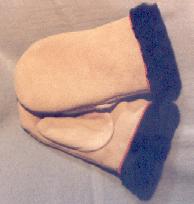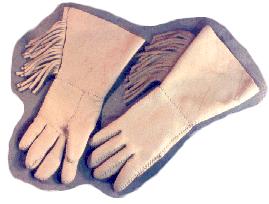
Mittens
and
Gloves
Heavy Weight Elk Hide Chopper Mittens
that I made with a separate rabbit fur
lining attached with beaded edging
at the cuff (Prindle 1997).
 |
Mittens |
Heavy Weight Elk Hide Chopper Mittens
|
A very useful source in learning
about chopper mittens (and other Native handiwork) is: Crafts
of the North American Indians; A Craftsman's Manual. (pg.s
95-104). Written, illustrated & published in 1972 by Richard
C. Schneider, 312 Linewood Ave., Stevens Point, Wisconsin 54481
ISBN: 0-936984-00-7.
There are few references for Native
American mittens before the 1800's. However, a few early historic
sources indicate that in extreme the climates it was necessary
to protect hands and arms against the cold. During the winters
in southern New England, mittens or gloves were worn by Native
Americans for fortification against the weather. In 1672, John
Josselyn (1972) mentions the hide of the Soile (seal) or Sea Calf,
"The Hair upon the
young ones is white, and as Ÿoft as Ÿilk; their Skins,
with the Hair on, are good to make Gloves for the Winter."
Between 1638 and 1663, Josselyn
(in Lindholdt 1988) also remarked on gloves made from otter fur
being the best protection for the hands in wet weather.
As there is scant evidence that
mittens and gloves were commonplace, it is likely that men and
women kept their hands tucked into their clothing, perhaps covered
up by arm protectors which have been mentioned in other early
historic documents from the northeast.

|
| Heavy Weight Elk Hide gauntlet gloves
that I made with fringed cuffs (Prindle1988). |
Some furs, especially that of
wild cat (perhaps bobcat, puma or eastern mountain lion) were
worn as arm guards to protect against wind and cold, while traveling
or hunting. In 1634, William Wood (1865) observed that in winter
Native American men wore these cat-fur arm protectors:
"MoŸt of them in
the Winter having his deepe furr'd Cat skinne, like a long large
muŸŸe, which hee Ÿhifts to that arme which lieth
moŸt expoŸed to the winde; thus clad, hee buŸles
better through a world of cold in a froŸt-paved wilderneŸŸe,
than the furred Citizen in his warmer Stoave."
In 1524 Verrazzano saw women wearing
embroidered deer skin mantles, while some women also wore "rich
lynx skins on their arms" (in Wroth 1970). In 1622 Mourt
(in Heath 1986), noted that only the Native American leader of
a group of men had a fur arm guard: "they had every man a
deer's skin on him and the principal of them had a wild cat's
skin, or such like on the one arm", which may reflect the
man's unique status.
There are many references to and
examples of mittens and gloves made by Native Americans during
the 1800's, a tradition which is continued today with several
styles of 'chopper mittens' (Schneider 1972), as well as gauntlet
gloves which were popularized in the 1800's by the U.S. calvery.

|
Text and Graphics
© 1994 - Tara Prindle unless otherwise cited. |